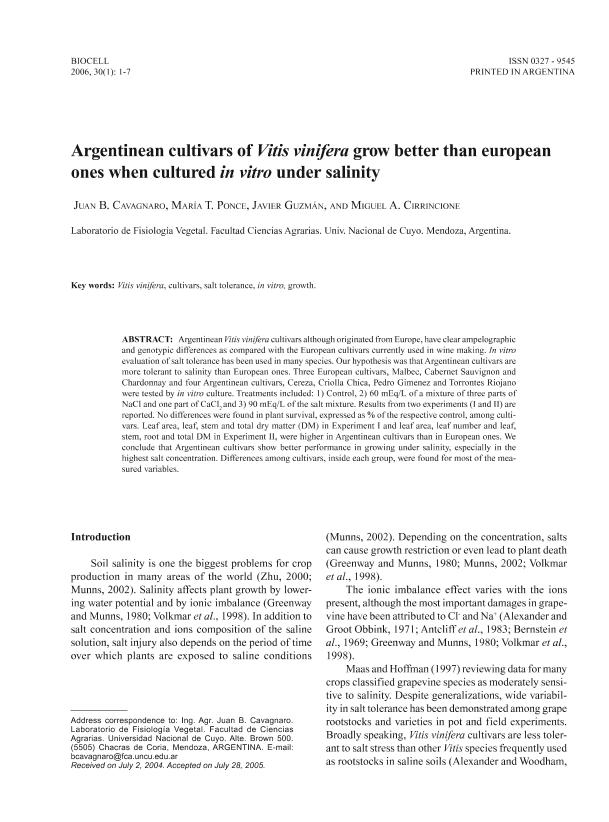Artículo
Argentinean cultivars of Vitis vinifera grow better than european ones when cultured in vitro under salinity
Fecha de publicación:
04/2006
Editorial:
Instituto de Histología y Embriología
Revista:
Biocell
ISSN:
0327-9545
Idioma:
Inglés
Tipo de recurso:
Artículo publicado
Clasificación temática:
Resumen
Argentinean Vitis vinifera cultivars although originated from Europe, have clear ampelographicand genotypic differences as compared with the European cultivars currently used in wine making. In vitroevaluation of salt tolerance has been used in many species. Our hypothesis was that Argentinean cultivars aremore tolerant to salinity than European ones. Three European cultivars, Malbec, Cabernet Sauvignon andChardonnay and four Argentinean cultivars, Cereza, Criolla Chica, Pedro Gimenez and Torrontes Riojanowere tested by in vitro culture. Treatments included: 1) Control, 2) 60 mEq/L of a mixture of three parts of NaCl and one part of CaCl2 and 3) 90 mEq/L of the salt mixture. Results from two experiments (I and II) are reported. No differences were found in plant survival, expressed as % of the respective control, among cultivars.Leaf area, leaf, stem and total dry matter (DM) in Experiment I and leaf area, leaf number and leaf,stem, root and total DM in Experiment II, were higher in Argentinean cultivars than in European ones. Weconclude that Argentinean cultivars show better performance in growing under salinity, especially in the highest salt concentration. Differences among cultivars, inside each group, were found for most of the measured variables
Palabras clave:
VITIS VINIFERA
,
CULTIVARS
,
SALT TOLERANCE
,
IN VITRO GROWTH
Archivos asociados
Licencia
Identificadores
Colecciones
Articulos(IBAM)
Articulos de INST.DE BIOLOGIA AGRICOLA DE MENDOZA
Articulos de INST.DE BIOLOGIA AGRICOLA DE MENDOZA
Citación
Cavagnaro, Juan Bruno; Ponce, María Teresa; Guzman, Javier; Cirrincione, Miguel Angel; Argentinean cultivars of Vitis vinifera grow better than european ones when cultured in vitro under salinity; Instituto de Histología y Embriología; Biocell; 30; 1; 4-2006; 1-8
Compartir




